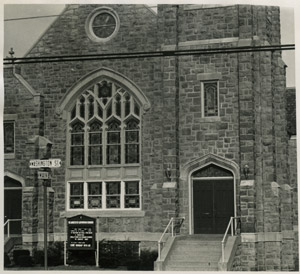
News & announcements
Saving your history
Early accounts
Maps
Nearby towns
People
Churches
Schools
Municipal
Organizations
Businesses
The mines
Transportation
Streets
Buildings
Entertainment
Celebrations
Sports
Ethnic groups
St. Luke's Lutheran Church
What's on this page:
- Beginnings
- In the time of the original wooden church
- In the time of the stone church
- 1976 Centennial booklet
- St. John’s Reformed United Church of Christ
- Eckley churches
- Sts. Peter and Paul Lutheran Church
- Joe Ranieri - builder of the current St. Luke’s church
At top left of page: Photo of St. Luke’s Evangelical Lutheran Church, from John Zubach.
Beginnings
[Text for this section was pulled from Charles Stumpf’s notes which included an English translation of Geschichte der Wilkes-Barre Konferenz des Evangelischen-Lutherischen Ministeriums von Pennsylvanian, 1898 (translated by Harold Koch), as well as from newspaper articles, and from St. Luke’s 1976 Centennial booklet, available in PDF for free download at bottom of this page.]
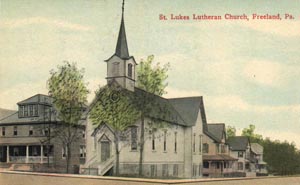 Some
time ago Bob Zimmerman told me this: “The establishment of the
Lutheran
Church in Freeland (1876) was preceded by services held in Highland and
Eckley. Rev. Schmidt and Rev. Bauer were two early itinerant pastors
who provided services.” Looking into the history of St. Luke’s, it
becomes more clear what those early times were like.
Some
time ago Bob Zimmerman told me this: “The establishment of the
Lutheran
Church in Freeland (1876) was preceded by services held in Highland and
Eckley. Rev. Schmidt and Rev. Bauer were two early itinerant pastors
who provided services.” Looking into the history of St. Luke’s, it
becomes more clear what those early times were like. In 1868, Rev. John Henry Schmidt was asked by the Superintendent of Missions of the Evangelical Lutheran Ministerium of Pennsylvania to take charge of the White Haven Mission, which included White Haven and Eckley, along with a number of preaching points in the coal region. He preached for the first time on June 29, 1868 and was elected pastor of White Haven Mission. Every other week he went out to preach at Eckley and other locations. In Freehold, Luther T. Dodson had been conducting Bible classes and Sunday School for the residents. There were not yet many homes in Freehold. The post office was in Woodside, and there was a one-room school for the children of Woodside, Freeland and South Heberton.
In 1868 there was a mixed group of Lutherans, Reformed and Presbyterians who resided in what is now Freeland and who began meeting for religious services in charge of Rev. Schmidt. This group held services in the Freehold school building. Not only were services held there, but Rev. Schmidt also journeyed at intervals to Upper Lehigh, Jeddo, Highland, and Eckley, where services were held in the schoolhouses. So Rev. Schmidt was in charge of the White Haven Mission and preaching to the Freeland group and to people in those other towns as well. Recall that this was in the days of horse and horse-drawn travel, and on those travel Sundays he would ride to various villages and end up preaching 4 or 5 times a day. Freehold (later Freeland) would not be founded until 1870.
The church in White Haven needed improvements, and he worked on those for the next seven years. At that point the congregation had grown to the extent that they decided they could afford to call their own exclusive pastor so that they could have services every week and not have their pastor spend so much time preaching in other towns. In 1875 he left there and moved to Freehold.
In the time of the original wooden church
Early pastors of St. Luke’s up to 1924:
Rev. John Henry Schmidt, 1876-1891
Rev. G. Biemueller, 1892-August 1893
Rev. John J. Kuntz, December 10, 1893 – 1909
Rev. David A. Roth, March 1, 1910 – October 31, 1926
Original trustees: Rev. J. H. Schmidt, August Donop, J. Goodman, Ernest Schabel, Henry Stark, John Düsing.
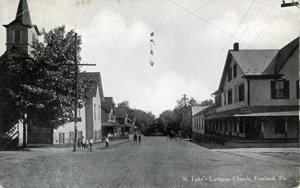
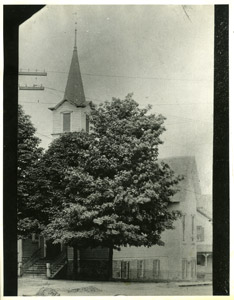 A
Lutheran church was begun in Freehold in 1874. Rev. Schmidt
moved to
Freehold on August 25, 1875, and by 1876 enough money had been raised
to start construction of a church building. Since St. Luke’s was the
first church in Freehold, adherents of many denominations contributed
to the building of it. Among those who have given the most, according
to the original list of signatures, were: the Upper Lehigh Coal Co.,
the Sandy Run Coal Co., Eckley B. Coxe from Drifton, G. B. Markle from
Jeddo, Rev. E. Greenwald, D.D., and Rev. J. Fry, D.D. [information from
Geschichte der Wilkes-Barre
Konferenz …, cited above and also at end of
page]
A
Lutheran church was begun in Freehold in 1874. Rev. Schmidt
moved to
Freehold on August 25, 1875, and by 1876 enough money had been raised
to start construction of a church building. Since St. Luke’s was the
first church in Freehold, adherents of many denominations contributed
to the building of it. Among those who have given the most, according
to the original list of signatures, were: the Upper Lehigh Coal Co.,
the Sandy Run Coal Co., Eckley B. Coxe from Drifton, G. B. Markle from
Jeddo, Rev. E. Greenwald, D.D., and Rev. J. Fry, D.D. [information from
Geschichte der Wilkes-Barre
Konferenz …, cited above and also at end of
page]The congregation was officially organized as St. Luke’s Evangelical Lutheran Church of Freeland. The present church is built on the site of the original wooden church. The lot was purchased from Joseph and Elizabeth Birkbeck the corner stone of which was laid on June 15th, 1876, a few months before Freehold was renamed Freeland and incorporated as a borough. Rev. Schmidt served as the pastor and also continued regular preaching at Upper Lehigh, Eckley, Jeddo, and occasionally at other locations. Every Sunday, services at St. Luke’s were held in both English and German, a custom that was continued into the 1920s.
1868 – Three years after the Civil War, a mixed group of Lutherans, Reformeds and Presbyterians met for the first time to hold church services under the leadership of Rev. J. H. Schmidt. Very few people lived in what is now Freeland at that time, so this group held services in the school, as well as in schoolhouses in Upper Lehigh, Jeddo, Highland and Eckley. (from June 24, 1954 newspaper article about 80th anniversary banquet)
1874 – Early in 1874, the Lutherans organized and applied for a charter. On April 29, 1874 the group was notified that their charter was accepted into the Evangelical Lutheran Ministerium of Pennsylvania and Adjacent States. (from June 24, 1954 newspaper article about 80th anniversary banquet)
1876 – August Donop, Sr. was sent to Rev. Schmidt to seek his opinion on building a church in Freehold. A congregational meeting was held on April 7th at Donop’s Hall, where it was decided to affiliate with the Evangelical Lutheran Ministerium of Pennsylvania and Adjacent States. A lot was bought and the church was built, the cornerstone laid on June 25, anniversary of the Augsburg Confession in 1530. That day services were held in a grove north of the building foundation with a large turnout from near and far. [I note the apparently conflicting information about whether affiliation with the Ministerium happened in 1874 or 1876. – CT]
The church is of wooden construction and cost approximately $2,100. In 1893 it was enlarged at an expenditure of $700. It seats 350 persons and the Sunday school room holds 225. The church has a bell, organ, and a baptismal fount. … The church property has a value of $4,500 [in 1898]. [Information from Geschichte der Wilkes-Barre Konferenz…, 1898, cited above and also at bottom of page]
April 22, 1877 – Consecration and Dedication of St. Luke’s. Sermons were preached in both German and English.
1882 – “… there arose a great disturbance on account of the union element.” To settle this beyond dispute, the congregation was incorporated as a Lutheran body. (Centennial booklet, p.6)
November 19, 1882 – The church was legally incorporated; the petitioners were: Rev. J. H. Schmidt, Henry Stark, Karl Hart, Christian Manke, Henry Discher, Michael Draheim and Jacob Mattis.
Not long after the founding of St. Luke’s, the number of deacons was increased so that there would be deacons in South Heberton, Oakdale, Upper Lehigh and Highland.
In 1882 the Reformed group left St. Luke’s and formed their own congregation, originally calling it St. John’s Union Church. In the German history of the area’s Lutheran churches written in 1898, that author wrote that the Reformed church proved to have just as large or perhaps a larger congregation than St. Luke’s. [Information from Geschichte der Wilkes-Barre Konferenz…, 1898, cited above and also at bottom of page]
A June 17, 1944 newspaper article mentioned the mixed group of Lutherans, Reformed and Presbyterians who resided in what is now Freeland in the 1870s, noting that “In a few years more and more people of the above sects came into the region and the groups began to segregate.” Naturally as the various denominational groups grew, they each got to the point where they wanted their own church.
1891 – Rev. Schmidt retired due to failing health; he left the congregation in good condition as a self-sustaining charge, free of debt.
1891-1893 – Although some people maintained that St. Luke’s was a church built by Germans and so was intended only for an exclusively German congregation, in fact much of the financial support for the original church came from English speaking people. From the very first services were held in both languages, but for a time German had the preference, and from 1891 to 1893 no English services were held. It became increasingly clear that this was an unsatisfactory situation, and so from 1893 the morning service was in German and the evening service in English, and since the language problem has been disposed of the congregation has been in a flourishing condition. [Information from Geschichte der Wilkes-Barre Konferenz…, 1898, cited above and also at bottom of page]
Standard-Speaker August 16, 1892: “Workmen commenced yesterday morning excavating for an extension to St. Luke’s Lutheran Church, corner of Washington and Main streets, Freeland. The basement and building will be extended sixteen feet to the rear.”
Freeland Tribune January 8, 1893: The original church building was recently enlarged, increasing seating capacity of both church and Sunday School, and the church will be rededicated next Sunday. At the rededication ceremony, preaching will be done in German and Slavonian in the morning, and in English in the evening.
Freeland Tribune June 22, 1896: “The twentieth anniversary of the laying of the corner stone of St. Luke’s Lutheran church will be celebrated the last three days of this month.“
1898 - Size of the congregation: Although the church began with only five regular members, by 1898 it numbered about 300. Through the migration of its members the church has a significant loss at the present time. Rev. J. H. Schmidt baptized 248 persons. Pastor Biemüller baptized 39 and the present pastor, Rev. J. J. Kuntz 57 – a total of 339. The number of communicants reaches about 225 a year. Since the founding a Sunday School was established in the church. Both languages were used. It enrolled about 225 pupils. For quite a long time this school was the only one in the area. It is now only Lutheran. It had a German and an English Superintendant. The young peoples’ department had an enrollment of 80. The Bible Class, which was taught by the pastor, had 25 pupils. Unfortunately the school had no library. [Information from Geschichte der Wilkes-Barre Konferenz…, 1898, cited above and also at bottom of page]
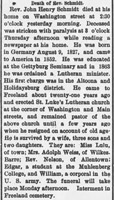 1899 – Death of Rev.
John Henry Schmidt, and thanks to Donna Maso for
this obituary.
1899 – Death of Rev.
John Henry Schmidt, and thanks to Donna Maso for
this obituary.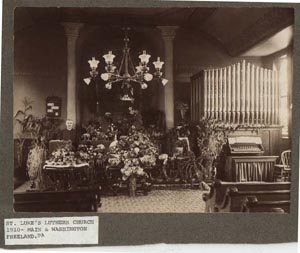 1910 –
Here is a view of the interior of St. Luke’s in the fall of
1910, when “Harvest Home” was being celebrated by Pastor David A. Roth.
A typed note taped to the back of the photo reads: “Cornerstone for the
first Lutheran church in Freeland was laid in June 1876. Small wooden
church dedicated on April 27, 1877 [NOTE: date given elsewhere as April
22, 1877 – CT.]
Located in a heavily wooded area, it was sometimes referred to as ‘the
church in the wildwood.’ About 20 years later church was enlarged to
seat 350. Cornerstone for new St. Luke’s laid August 31, 1924. Stone
was carried from Rainieri’s quarry about 8 blocks from the site, corner
of Main and Washington streets. As the church neared completion the
supply of stone began to run out. However, with careful planning, the
impressive stone structure was finished. Shown above is interior of St.
Luke’s in the fall of 1910 as ‘Harvest Home’ was celebrated by Pastor
D. A. Roth.” The photo came from Charlie Stumpf.
1910 –
Here is a view of the interior of St. Luke’s in the fall of
1910, when “Harvest Home” was being celebrated by Pastor David A. Roth.
A typed note taped to the back of the photo reads: “Cornerstone for the
first Lutheran church in Freeland was laid in June 1876. Small wooden
church dedicated on April 27, 1877 [NOTE: date given elsewhere as April
22, 1877 – CT.]
Located in a heavily wooded area, it was sometimes referred to as ‘the
church in the wildwood.’ About 20 years later church was enlarged to
seat 350. Cornerstone for new St. Luke’s laid August 31, 1924. Stone
was carried from Rainieri’s quarry about 8 blocks from the site, corner
of Main and Washington streets. As the church neared completion the
supply of stone began to run out. However, with careful planning, the
impressive stone structure was finished. Shown above is interior of St.
Luke’s in the fall of 1910 as ‘Harvest Home’ was celebrated by Pastor
D. A. Roth.” The photo came from Charlie Stumpf. In the time of the stone church
Later pastors of St. Luke’s since 1924:
Rev. David A. Roth, March 1, 1910 – October 31, 1926
Rev. Fred D. Haffner, June 1, 1927 – 1962 (or 1963)
Rev. H. Raymond Jones, 1963 – 1973 (or December 15, 1964 – December 31, 1974)
Rev. William W. Fairchild, June 2, 1974 – ____
[List needs to be updated. – CT]
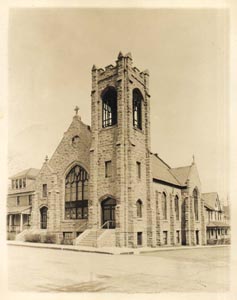
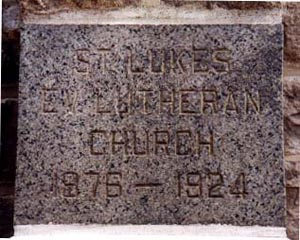 August 31, 1924: The cornerstone for the
present church building was laid, and the building was completed in
1926. The cornerstone has the dates when the cornerstones for
the two St. Luke’s churches were laid: 1876 – 1924. The new
construction was done by master stonemason Joseph Ranieri and his crew, who also
built the second St. John Nepomucene Roman Catholic Church on Vine
street. (This sepia photo of St. Luke’s church came from John Zubach)
The corner stone was donated by the Thomas Granite Works, of Hazleton.
August 31, 1924: The cornerstone for the
present church building was laid, and the building was completed in
1926. The cornerstone has the dates when the cornerstones for
the two St. Luke’s churches were laid: 1876 – 1924. The new
construction was done by master stonemason Joseph Ranieri and his crew, who also
built the second St. John Nepomucene Roman Catholic Church on Vine
street. (This sepia photo of St. Luke’s church came from John Zubach)
The corner stone was donated by the Thomas Granite Works, of Hazleton.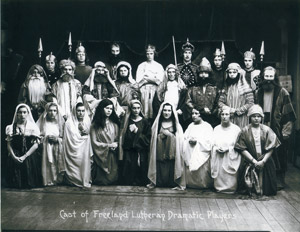 Lutheran Dramatic Players,
1930: St. Luke’s formed many clubs and societies for its
members, such as the Dramatic Club: “This club was formed by Mr. Oscar
Fairchild and presented plays on the religious side and had men, women,
boys and girls from St. Luke’s in the case. They met every week for
rehearsals whenever the club had a play to be presented. Otherwise they
met once a month for a business meeting.” This 1930 photo comes from
Bob Zimmerman.
Lutheran Dramatic Players,
1930: St. Luke’s formed many clubs and societies for its
members, such as the Dramatic Club: “This club was formed by Mr. Oscar
Fairchild and presented plays on the religious side and had men, women,
boys and girls from St. Luke’s in the case. They met every week for
rehearsals whenever the club had a play to be presented. Otherwise they
met once a month for a business meeting.” This 1930 photo comes from
Bob Zimmerman. Standard-Speaker June 24, 1931: St. Luke’s Evangelical Lutheran Church will celebrate 55th anniversary of cornerstone laying on June 28, 30 and July 1-2. Pastor Rev. Fred D. Haffner invites the public to attend. All of the special offerings of anniversary week will be devoted to the building fund.
The article includes the following early history [excerpted]: On the 7th of April, 1876, the St. Luke’s Evangelical Lutheran church, of Freeland and Highland, Luzerne county, Pennsylvania, founded a short time previous, voted to become affiliated with the Evangelical Lutheran Ministerium of Pennsylvania and adjacent states. Under the able direction of the Rev. J. H. Schmidt, plans were made to purchase a lot and start building a church. On the 25th of June, 1876, the corner stone was laid. The Rev. E. Greenwald, D.D., president of synod, appointed Rev. F. W. Weiskotten and Rev. E. A. Baur, to serve in his stead. At the conclusion of the afternoon services the pastor laid the corner stone. … Since the founding of St. Luke’s five pastors have served the congregation. The following sons of the congregation have entered the ministry: Rev. Nelson Schmidt, Rev. Frank Kuntz, Rev. Allen Roth, Rev. Chas. Holland.”
Plain Speaker June 17, 1944: Special services to mark St. Luke’s 70th anniversary, also the 20th anniversary of the erection of the present church building, and the 25th anniversary of Rev. Fred D. Haffner’s ordination as a minister. “The present building is built on the site of the first church, the corner stone of which was laid on June 15th, 1876, the same year that Freeland was incorporated as a borough. … St. Luke’s congregation dates back 76 years to 1868, when a mixed group of Lutherans, Reformed and Presbyterians who resided in what is now Freeland met for religious services in charge of the Rev. J. H. Schmidt. This group held services in the Freeland school building. Not only were services held in town, but Rev. Schmidt journeyed at intervals to Upper Lehigh, Jeddo, Highland, and Eckley, where services were held in the schoolhouses. In a few years more and more people of the above sects came into the region and the groups began to segregate. A Lutheran church was formed in 1874 and by 1876 enough money had been raised to start the erection of a church, which was built on the site of the present edifice. Rev. Schmidt continued to serve as the pastor of the Lutheran group, and every Sunday services were held in English and German, a custom that was continued until about 20 years ago. …”
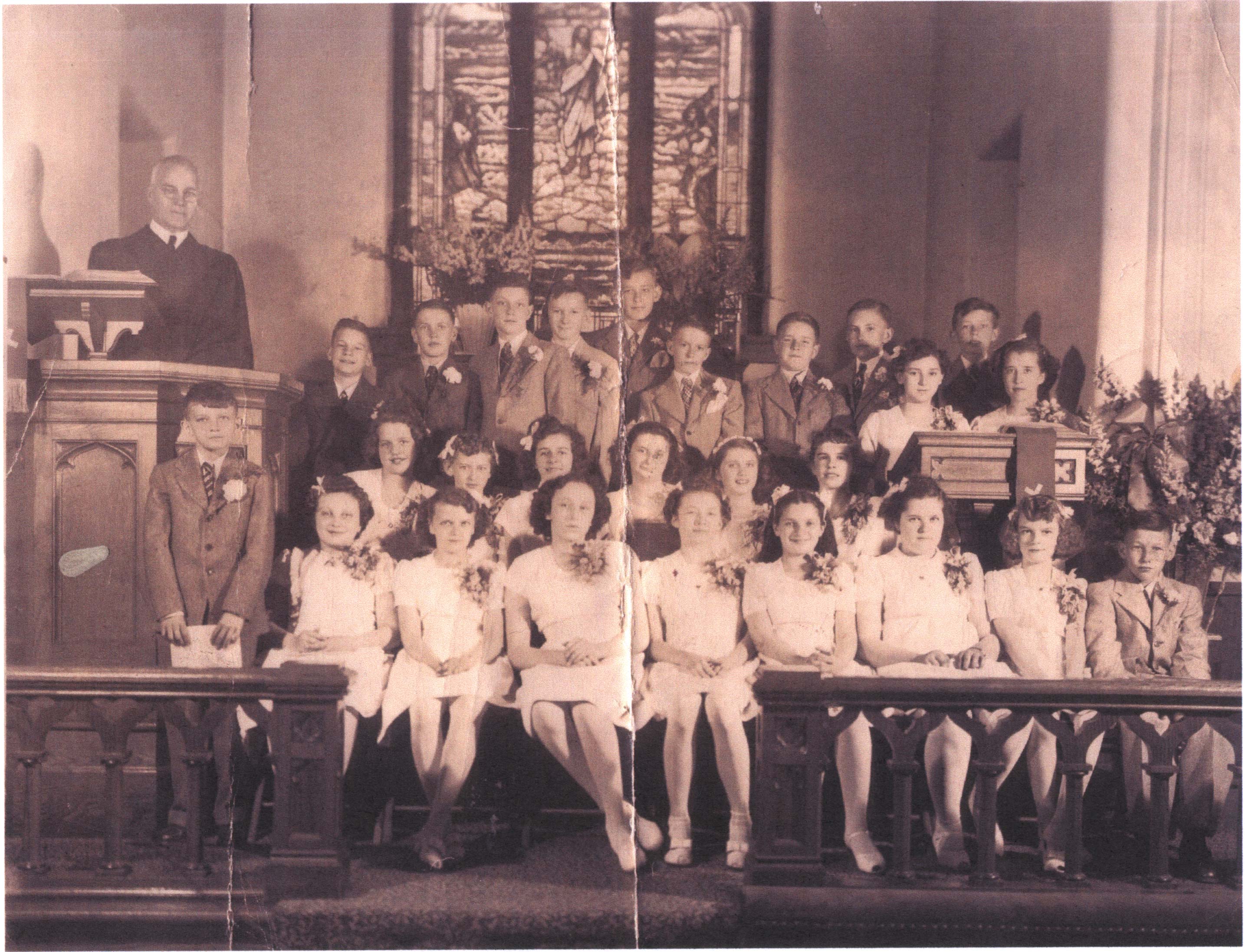 1945 – Shown here is St. Luke's
confirmation class in 1945: 11
boys and 15 girls. Thanks to Bill Smith for sharing this photo.
1945 – Shown here is St. Luke's
confirmation class in 1945: 11
boys and 15 girls. Thanks to Bill Smith for sharing this photo.News clipping June 24, 1954: 80th Anniversary Dinner At St. Luke’s Church Tonight
[summarized] A banquet will celebrate the 80th anniversary of the founding of the church and the 30th anniversary of the laying of the cornerstone of the stone church. Guest speaker is Rev. Allen Roth, pastor of the Christ Lutheran Church in Hazleton and son of Rev. D. A. Roth, former pastor of St. Luke’s. Present pastor Rev. Fred D. Haffner will also take an active role in the evening. He is beginning his 28th year at St. Luke’s, having served the longest tenure of any of the five ministers who have served the congregation. Master of Ceremonies for the evening will be August L. Mitke, a Freeland native who was an active worker in St. Luke’s parish and who was a founder and moving spirit of the Lutheran Men’s Bible Class, building it into one of the most active classes in the entire Freeland and Hazleton area.
… [among the historical notes in the same article is this:]
“… An unusual feature of the present structure is that it is built of local material. Members of the congregation believe it is the only such building on the North Side.” [*** NOT TRUE: In 1915 St. John’s Nepomucene Roman Catholic Church had their second church built using stone from the same source, the Ranieri quarry.]
“Stone for the church came from Joseph Ranieri’s stone quarry which was located at South Hemlock and Green streets, in the Woodside section of Foster Township. As the church neared completion the stone supply was reaching exhaustion, and it was feared there would not be enough stone to complete the building. However, enough stone was quarried and the church was finished.”
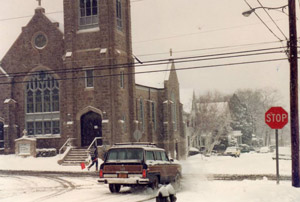
Winter 1987 – Ed Merrick took this photo in 1987, a great view of the church and its surroundings.
1976 Centennial booklet
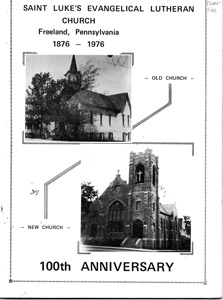
 St. Luke's
Centennial, 1876-1976 - (PDF file size = 5.6 MB)
St. Luke's
Centennial, 1876-1976 - (PDF file size = 5.6 MB)Thank you to Charlie Stumpf for research and for the Harold Koch translation of Geschichte der Wilkes-Barre Konferenz des Evangelischen-Lutherischen Ministeriums von Pennsylvanian, 1898; to Ed Merrick for research and clippings; to Donna Maso for Rev. Schmidt information; and to John Zubach, Bill Smith, Bob Zimmerman, Ed Merrick and Charlie Stumpf for photos.